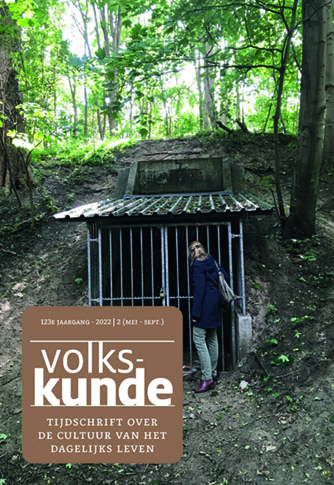Castles as Art Repositories in Wartime
The hidden and lost collections of the Dutch Open-Air Museum
(Nederlands Openluchtmuseum)
Ingrid D. Jacobs
At the end of the 1930s, the Dutch State Inspectorate for Art Protection (Nederlandse Rijksinspectie
Kunstbescherming) stood up to protect monuments, heritage and museum collections from war threats.
The most valuable possessions were stored in basements, strongrooms, school buildings, churches, and even
on ships. Concrete bunkers were constructed in the dunes to store works of art. Because all of this was
insufficient, castle owners were also asked to make their premises available to Art Protection. The noble owners
happily granted this request to avoid billeting. Storing museum collections (in full awareness of the occupier) was
common practice in The Netherlands as well as elsewhere in Europe.
From 1942 castles were arranged and used for this aim. In Gelderland the Doornenburg and Nederhemert castles stored large ethnological collections of the Dutch Open-Air Museum (Nederlands Openluchtmuseum), which was situated perilously close to the German military airbase Fliegerhorst Deelen.
Curators of the museum selected the most precious or irreplaceable objects. What criteria did they use?
Was their selection based on expertise or pragmatism, or was it arbitrary? Unfortunately, both castles were
completely destroyed in the spring of 1945. As the inventories have survived, we know exactly what was
lost, which gives us insight into a hidden chapter of museological history. In Nederhemert this mainly
regarded farm furniture, large sleighs (arrensleden), riggings and jewellery.
At Doornenburg regional costumes, slip shoes, undervests and cradle cloths were lost. Further analysis and
research into the lost collections will make clear what value was attributed to this ethnological heritage at the
time.
How to live a long and sound life
of 72 years according to a popular
almanac from 1520: Der scaepherders
kalengier printed by Adriaen van
Berghen
Marie-Charlotte Le Bailly
Earlier this year the Heritage Library Hendrik Conscience acquired a unique post-incunable almanac
printed in Antwerp by Adriaen van Berghen in 1520: Der scaepherders kalengier. This is a valuable addition
to the extensive collection of (at least 500) almanacs printed before 1800 that the library possesses. This
paper first describes this particular collection and discusses the characteristics of almanacs in general and their potential as a source for historical and sociological research in the early modern period. Shepherd’s calendars were a specific type of almanac. Contrary to what the title implies, they did not target shepherds at all but were especially meant for a civic audience. The idealized shepherd, who speaks the foreword, symbolizes a long and sound life.
Shepherd’s calendars like Van Berghen’s were incredibly popular in sixteenth-century Europe, especially in the Low Countries. Secondly, this paper analyses the contents and the woodcuts in Adriaen van Berghen’s Der scaepherders kalengier and compares them with other popular shepherd’s calendars printed by Thomas van der Noot and Willem Vorsterman.
Finally, as Van Berghen clearly had a flair for popular works, this paper fits Der scaepherders kalengier within the
context of Van Berghen’s publisher’s list.
Project Ortelius: Online Groups as an Addition to the Heritage Network?
Rik De Lombaerde & Sofie De Ruysser
Since the introduction of the internet, social media and smartphones, the online universe takes in a considerable and meaningful place in the daily life of many. Digitalization and online connectivity give rise to new communities that take
shape according to their logic and dynamics. ErfgoedLab Antwerpen launched Project Ortelius as a means to experimentally explore whether the paradigms of physical heritage (e.g. transmission, significance assessment) could also apply to the digital and online world. Can (some) social media groups be considered heritage communities? Are their actions comparable to heritage communities in the physical world? Project Ortelius started by focusing on Facebook groups, using a double approach. A series of eight interviews with key figures and administrators of
Facebook groups in Antwerp allowed the detection of the intentions and strategies of these groups, the way
they perceive their relationship to heritage and the way their activities could (or couldn’t) be compared to
heritage processes (e.g. identification, research, conservation, education).
Alongside, quantitative research was done using search terms, API and scraping. This brought the initial
2306 Facebook groups down to 803 with a heritage potential in Antwerp.
These can be categorized into seven types of groups with different associations with heritage processes.
Project Ortelius proves to be vulnerable in its innovative experimentalism.
However, the project demonstrates there is still much potential, both at the level of formation of concepts and
methodologies to facilitate further research, and in the possibilities to address online groups as heritage
communities.
Dancing Giants and the omegang in Lier of 1722/2023
Johan Verberckmoes
On Saturday 8 October 2022 a conference was organized on giants in processions and ommegangen
(parades) in the 18th century and on the occasion of a new parade in Lier (Belgium) with the historical giants
on 2 and 9 October. Such parades and the families of giants (spouses, children, housemaids) in them were remarkably resilient in the eighteenth century and even survived French occupation of the part of the Netherlands which form today’s Belgium. This is a plea for thorough archival and iconographic research into the history of giant puppets
that aroused collective emotions and steered historical memories of many cities in the southern Netherlands
and northern France, as is still the case today. Recognized by the Flemish government as immaterial cultural heritage, some giants have survived centuries, while others are newly created. All generate(d) intense emotion and reflection. In Wallonia, research on this has been historical as well as international oriented.
Research in Flanders is often only local. Diachronic and synchronic European research on giants opens up new perspectives.


